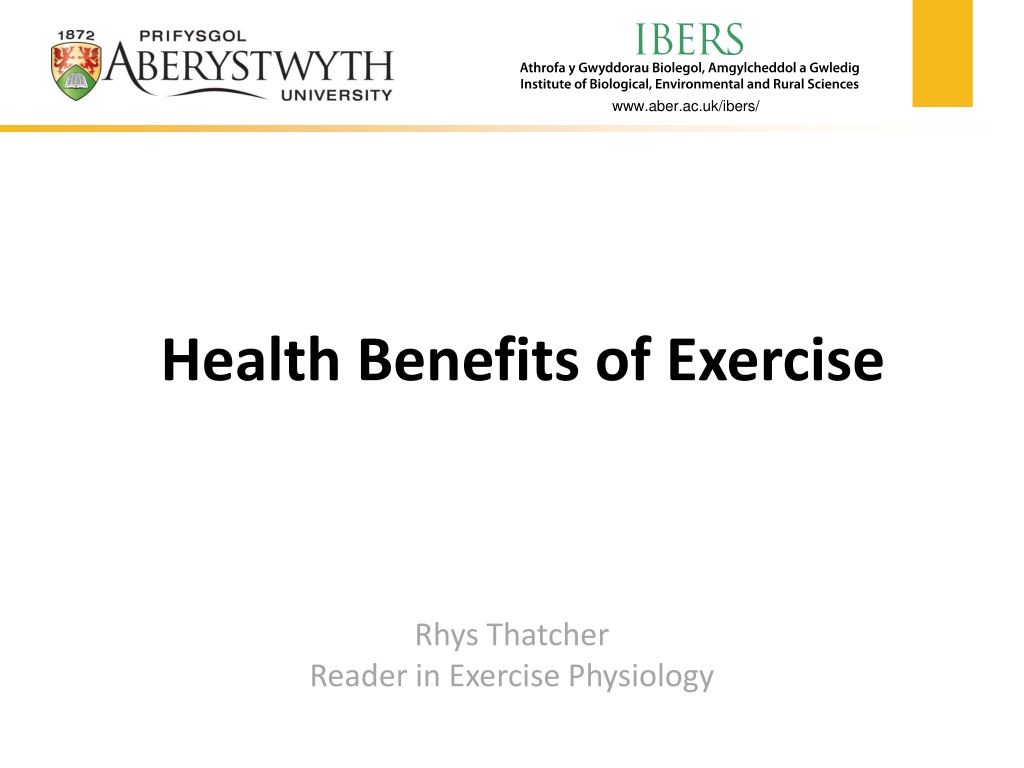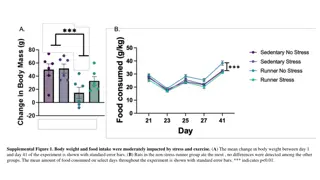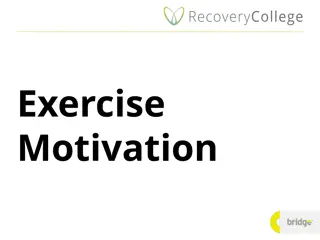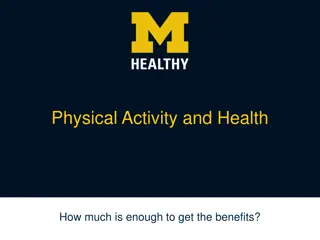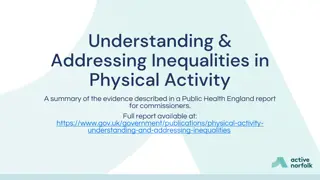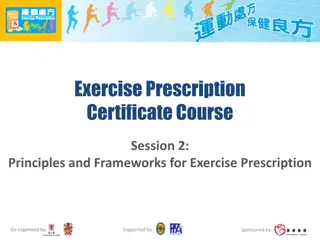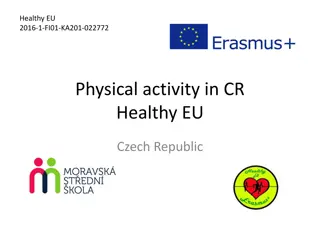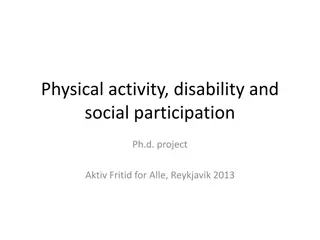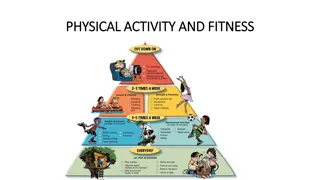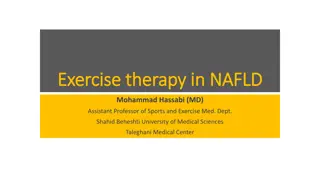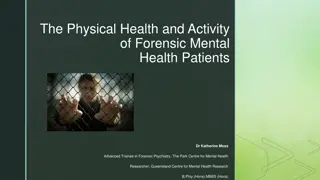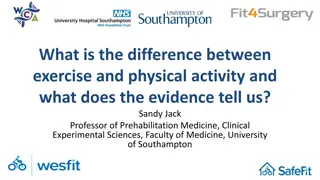Exploring the Health Benefits of Exercise and Physical Activity at www.aber.ac.uk/ibers/
Delve into the relationship between physical activity, fitness, and mortality through insightful studies such as the Harvard Alumni Health Study and research by Paffenbarger et al. Discover the impact of exercise on reducing the risk of dying and improving overall health. Explore early work in sport and exercise science that has shaped physical activity guidelines. Uncover the significant findings and implications brought by these studies conducted over the years.
Uploaded on Jul 13, 2024 | 0 Views
Download Presentation

Please find below an Image/Link to download the presentation.
The content on the website is provided AS IS for your information and personal use only. It may not be sold, licensed, or shared on other websites without obtaining consent from the author. Download presentation by click this link. If you encounter any issues during the download, it is possible that the publisher has removed the file from their server.
E N D
Presentation Transcript
www.aber.ac.uk/ibers/ Health Benefits of Exercise Rhys Thatcher Reader in Exercise Physiology
www.aber.ac.uk/ibers/ Physical Activity and All Cause Mortality The relationship between physical activity/fitness and the risk of dying
www.aber.ac.uk/ibers/ Sport and Exercise Science As Sport and Exercise Scientists we try to understand what limits human performance and how exercise can improve health Some of the work that was performed in the 60s, 70s and 80s helped us understand the relation between physical activity and health and informed the physical activity guidelines We will now look at some of this early work
www.aber.ac.uk/ibers/ PA and All Cause Mortality All cause mortality relates to death from any cause cancer, heart disease, viruses, accidents, etc. We will not be examining why fit/active people live longer only establishing whether or not they do
www.aber.ac.uk/ibers/ Harvard Alumni Health Study In 1986 a study was published by a group of researcher in the United States of America, they recruited 16936 men, all Harvard alumni, aged between 35 and 74 years Baseline data were collected in 1962 or 1966 and followed up in 1978 (12 16 year later) at which point 1413 men had died They also collected data on how much activity the men had done in a typical week There was an inverse dose-response relationship between PA and risk of dying See next slide These finding have been supported by numerous other studies
www.aber.ac.uk/ibers/ Paffenbarger et al. (1986) 1 1 0.9 0.78 0.8 0.73 0.7 0.63 0.62 0.62 Risk of Death 0.6 0.52 0.46 0.5 0.4 0.3 0.2 0.1 0 <500 >3499 500-999 1000-1499 Physical Activity Index (kcal.wk-1) 1500-1999 2000-2499 2500-2999 3000-3499 Men who burnt 3000-3499 kcal per week in physical activity were 46% (less than half) as likely to have died during the 12 16 years of follow up when compered to the men who burnt less that 500 kcal
www.aber.ac.uk/ibers/ Fitness and All Cause Mortality Another study published in 1989 compared people s fitness and all cause mortality Fitness is a lot easier to measure than activity 10224 men and 3120 women completed an exercise test on a treadmill During an eight year follow up 240 men and 43 women died Subjects were split into quintiles based on fitness 1 = lowest fitness group 5 = highest fitness group See graph on next slide The lower mortality rates in the higher fitness groups were attributed to lower rates of CVD and cancer
www.aber.ac.uk/ibers/ Blair et al. (1989) 5 4.65 Men Women 4 Relative Risk of Death 3.44 3 2.42 2 1.46 1.43 1.37 1.17 1 1 1 0.76 0 1 2 3 4 5 Fitness Group Men in the lowest fitness group were 3.44 time more likely to have died during the eight year follow up when compered to the fittest men, while women in the lowest fitness group were 4.65 time more likely to have died during the eight year follow up when compered to the fittest women
www.aber.ac.uk/ibers/ Fitness Compared to Other Risk Factors Blair et al. (1996) also compared low fitness to other well known risk factors 2.5 Men Women 2.1 1.99 2 Relative Risk of Death 1.65 1.52 1.5 1.34 1.3 1.09 1.02 0.94 1 0.76 0.5 0 Low Fitness Smoking Hypertension High Overweight Cholesterol Risk Factor Low fitness has a larger risk of death for both men and women than having high blood pressure, high cholesterol or been overweight and for women it is a larger risk than smoking
www.aber.ac.uk/ibers/ Physical Activity/Fitness and All Cause Mortality Both physical activity and physical fitness (aerobic fitness) are associated with reductions in all cause mortality. Stronger links have been found with fitness but this could be due to the problems with measuring physical activity As well as living longer there is a lot of evidence linking physical activity and improved quality of life, especially in elderly populations This is particularly important as we are living in an aging society as medical care, better food availability and general health and safety increases the length of people lives See next slide
www.aber.ac.uk/ibers/ Change in UK age profile from 1901 - 2010 5 1901 2010 Number of people in milions 4.5 4 3.5 3 2.5 2 1.5 1 0.5 0 Age group in years
www.aber.ac.uk/ibers/ References Blair, S.N., Kampert, J.B., Kohl, H.W., Barlow, C.E., Macera, C.A., Paffenbarger, R.S. and Gibbons, L.W. (1996). Influences of cardiorespiratory fitness and other precursors on cardiovascular disease and all-cause mortality in men and women. Journal of the American Medical Association, 276, 205-10. Blair, S.N., Kohl, H.W., Paffenbarger, R.S., Clark, D.G., Cooper, K.H. andGibbons, L.W. (1989). Physical fitness and all-cause mortality. A prospective study of healthy men and women. Journal of the American Medical Association, 262, 2395-401. Paffenbarger, R.S., Hyde, P.H.R.T., Wing, A.L. and Hsieh, C-C. (1986) Physical activity, all-cause mortality, and longevity of college alumni. New England Journal of Medicine, 314, 605-13.
